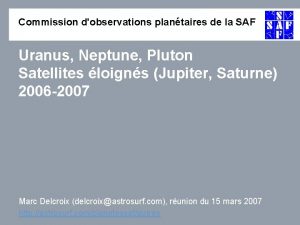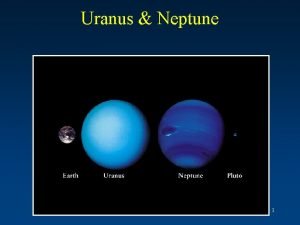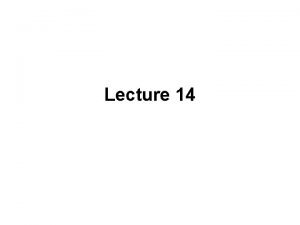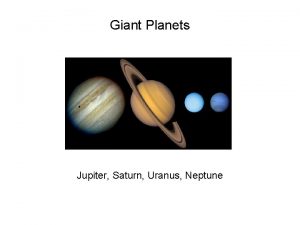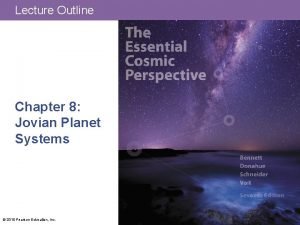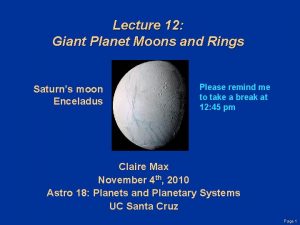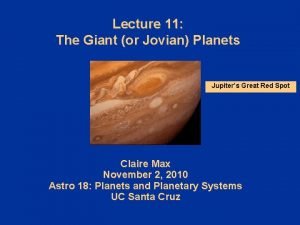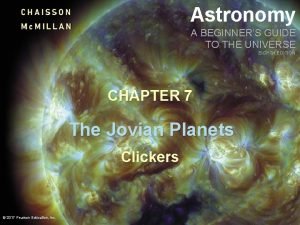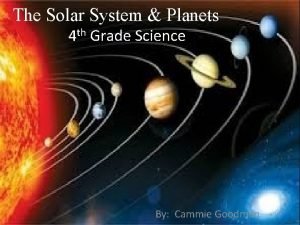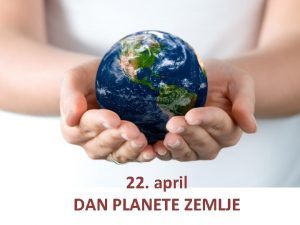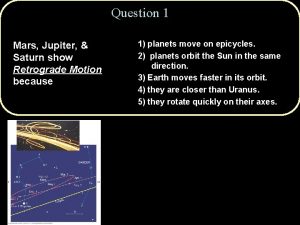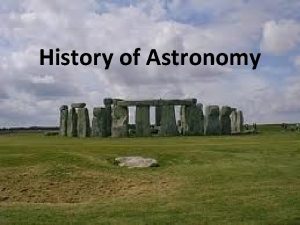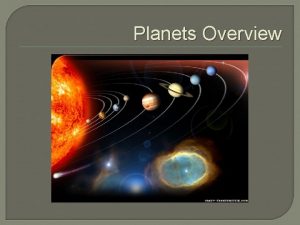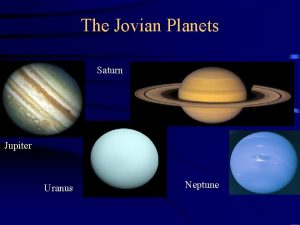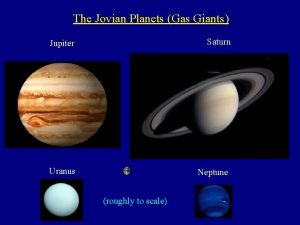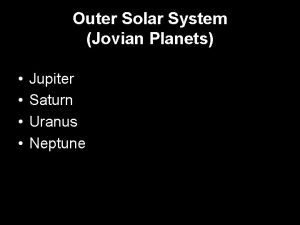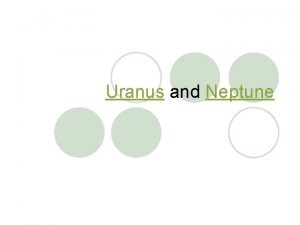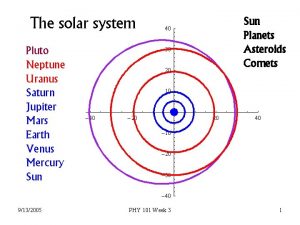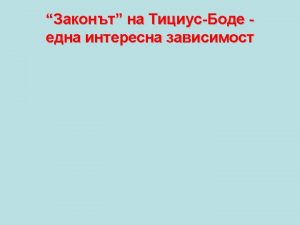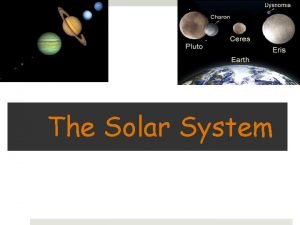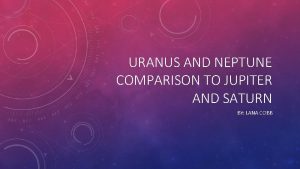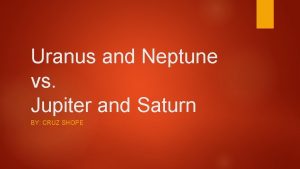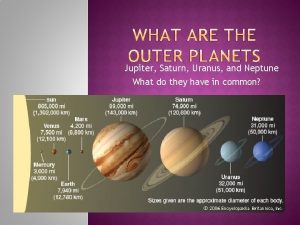The Jovian Planets Jupiter Saturn Uranus Neptune roughly















- Slides: 15

The Jovian Planets Jupiter Saturn Uranus Neptune (roughly to scale) 1

Discoveries Jupiter and Saturn known to ancient astronomers. Uranus discovered in 1781 by William Herschel. Neptune predicted to exist by John Adams and Urbain Leverrier because of irregularities in Uranus' orbit. Discovered in 1845 by Johann Galle. 2

Basic Properties Mass (MEarth) Jupiter Radius (REarth) Orbit semi-major axis Orbital Period (AU) (years) 318 11 5. 2 11. 9 Saturn 95 9. 5 29. 4 Uranus 15 4 19. 2 84 Neptune 17 3. 9 30. 1 164 (0. 001 MSun) Major Missions Launch Voyager 1 1977 Planets visited Jupiter, Saturn Voyager 2 1979 Jupiter, Saturn, Uranus, Neptune Galileo 1989 Jupiter Cassini 1997 Jupiter, Saturn 3

Jupiter's Atmosphere and Bands Whiteish "zones" and brownish "belts". Optical – colors dictated by how molecules reflect sunlight Infrared - traces heat in atmosphere, therefore depth So white colors from cooler, higher clouds, brown from warmer, lower clouds. Great Red Spot – very high. 4

Composition: mostly H, some He, traces of other elements (true for all Jovians). Gravity strong enough to retain even light elements. Mostly molecular. Spectroscopy of reflected sunlight reveals which molecules present. Altitude 0 km defined as top of troposphere (cloud layer) NH 4 SH (NH 3) These molecules should all give white clouds. Molecules responsible for colors actually not clear! 5

- Zones and belts mark a convection cycle. Zones higher up than belts. - Zones were thought to be where warm gas rises, belts where cooled gas sinks. Now less clear after Cassini, which found rising gas and falling gas confined to the belts! - - Jupiter's rapid rotation stretches them horizontally around the entire planet. - Winds flow in opposite directions in zones vs. belts. Differences are hundreds of km/hr. backup link 6

Other Jovian planets: banded structure and colors More uniform haze layer makes bands less visible. Reason: weaker gravity allows clouds to rise higher and spread out to create more uniform layer Blue/green of Uranus and blue of Neptune due to methane. Colder than Jupiter and Saturn, their ammonia has frozen and sunk lower. Methane still in gas form. It reflects blue light. 7

Storms on Jovian Planets Jupiter's Great Red Spot: A hurricane twice the size of Earth. Has persisted for at least 340 years. Reaches highest altitudes. New storm “Oval BA” backup link 8

"white ovals" - may last decades "brown ovals" - only seen near 20° N latitude. Not known why. May last years or decades Neptune's Great Dark Spot: Discovered by Voyager 2 in 1989. But had disappeared by 1994 Hubble observations. About Earth -sized. Why do these storms last so long? 9

Jupiter's Internal Structure Can't observe directly. No seismic information. Must rely on physical reasoning and connection to observable phenomena. (acts like a liquid metal, conducts electricity) Core thought to be molten or partially molten rock, maybe 25 g/cm 3, and of mass about 10 -15 MEarth. Other Jovians similar. Interior temperatures, pressures and densities less extreme. 10

11

Rapid rotation causes Jupiter and Saturn to bulge: Gravity without rotation with rotation Jupiter and Saturn rotate every ~10 hours. Radius at equator several % larger due to bulge. 12

Juno mission Juno. Launched Aug 5, 2011. Arrives 2016. Will study Atmospheric chemistry, internal structure, magnetosphere. Careful gravity measurements should reveal whether it has a solid core or not. Not expected in grav instab. Model. May settle the zones/belts issue. Will probe chemistry Deeper than before. Composition, temperature, clouds, motions. Cost $1 billion. 13

Differential Rotation period is shorter closer to the equator: Near poles At equator Jupiter 9 h 56 m 9 h 50 m Saturn 10 h 40 m 10 h 14 m Uranus 16 h 30 m 14 h 12 m How do we know? Tracking storms at various latitudes, or using Spectroscopy and Doppler shift. 14

Uranus' rotation axis is tilted by 98 o Why? Unknown. Perhaps an early, grazing collision with another large body. 15
 Why are jovian planets bigger than terrestrial
Why are jovian planets bigger than terrestrial Neptune jovian
Neptune jovian Phase diagram methane
Phase diagram methane Uranus outline
Uranus outline Uranus neptune size comparison
Uranus neptune size comparison Why do jovian planets have rings
Why do jovian planets have rings Why do jovian planets have rings
Why do jovian planets have rings Why do jovian planets have rings
Why do jovian planets have rings The two outer jovians appear bluish in color because
The two outer jovians appear bluish in color because The two outer jovian planets appear bluish in color because
The two outer jovian planets appear bluish in color because What does jupiter have in common with neptune brainpop
What does jupiter have in common with neptune brainpop Neptun saturn
Neptun saturn Mars jupiter and saturn show retrograde motion because
Mars jupiter and saturn show retrograde motion because Mars jupiter and saturn show retrograde motion because
Mars jupiter and saturn show retrograde motion because What separates inner and outer planets
What separates inner and outer planets Are all outer planets gas giants
Are all outer planets gas giants

